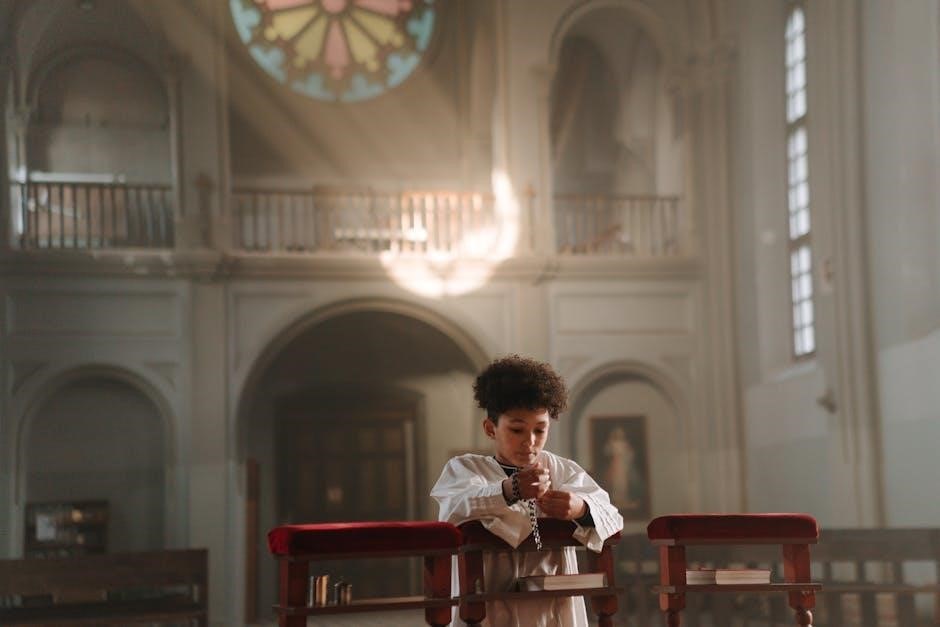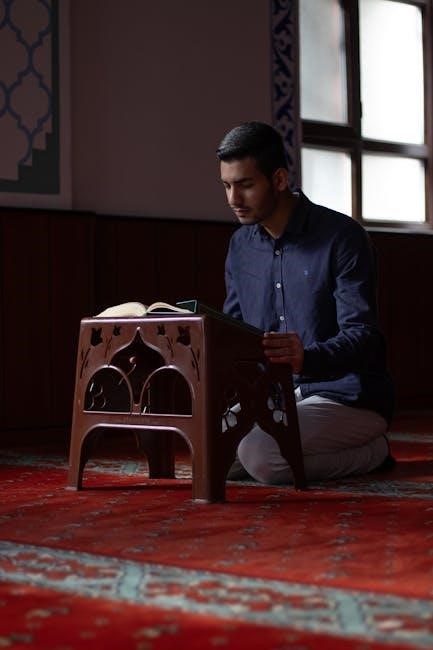Holy Rosary Thursday is a day dedicated to honoring the Blessed Virgin Mary and the Holy Rosary, emphasizing prayer, meditation, and spiritual connection through its sacred mysteries.
Significance of Holy Rosary Thursday in Catholic Tradition
Holy Rosary Thursday holds profound significance in Catholic tradition, marking a day dedicated to the veneration of the Blessed Virgin Mary and the Holy Rosary. It emphasizes the Rosary as a powerful devotion, combining prayer and meditation on the life of Jesus and Mary. The structure of the Rosary, including the Apostles’ Creed, Our Father, Hail Marys, Glory Be, and the Fatima Prayer, reflects its deep spiritual roots. The mysteries—Joyful, Sorrowful, Glorious, and Luminous—guide believers in contemplating key events of faith. This day underscores the Rosary’s role in fostering faith, hope, and love, and its ability to draw believers closer to God through Mary’s intercession.
The Structure of the Holy Rosary
The Holy Rosary is a structured prayer combining meditations on sacred mysteries with specific prayers, including the Apostles’ Creed, Our Father, Hail Mary, Glory Be, and Fatima Prayer.
Key Components of the Rosary Prayer
The Rosary prayer is composed of several essential elements that guide the devotion. It begins with the Apostles’ Creed, a declaration of faith, followed by the Our Father, a prayer emphasizing unity and forgiveness. The Hail Mary is central, repeated in decades to venerate Mary and reflect on the life of Christ. The Glory Be concludes each decade, glorifying the Holy Trinity. Additionally, the Fatima Prayer is often included, seeking mercy and salvation. These prayers, combined with meditative reflection on the Mysteries, form the heart of the Rosary, fostering spiritual growth and intercession through Mary’s guidance.
The Role of Mysteries in the Rosary
The mysteries of the Rosary are meditative reflections on pivotal events in the lives of Jesus Christ and the Blessed Virgin Mary. Divided into four sets—Joyful, Sorrowful, Glorious, and Luminous Mysteries—they guide the faithful in contemplating the sacred narratives of faith. Each mystery is rooted in Scripture and tradition, offering insights into the divine plan. By reflecting on these mysteries, the faithful seek to imitate the virtues of Jesus and Mary, fostering spiritual growth and deepening their connection to God. The mysteries also serve as a means to invoke Mary’s intercession, asking for her guidance and grace in living a life aligned with Christ’s teachings.

Prayers of the Holy Rosary
The Holy Rosary comprises the Apostles’ Creed, Our Father, Hail Mary, Glory Be, and the Fatima Prayer, each fostering deep meditation, reflection, and Mary’s loving intercession.
The Apostles Creed and Our Father
The Apostles Creed outlines the Catholic faith, affirming belief in God, the Trinity, and the resurrection. It begins the Rosary, setting a foundation of belief and devotion. The Our Father, taught by Jesus, follows, emphasizing divine will, forgiveness, and protection. These prayers are integral to the Rosary’s structure, uniting worshippers in shared faith and intention. Together, they establish a spiritual framework for meditating on the mysteries, seeking divine guidance, and invoking Mary’s intercession. Their recitation fosters unity and reflects core Christian teachings, grounding the Rosary in tradition and sacred doctrine.
Hail Mary, Glory Be, and the Fatima Prayer
The Hail Mary honors the Virgin Mary, seeking her intercession and praising her divine role. The Glory Be glorifies the Holy Trinity, emphasizing the eternal nature of God. The optional Fatima Prayer, added later, calls for mercy and the salvation of souls, reflecting devotion to Mary and her role in leading humanity to Christ. These prayers are central to the Rosary, fostering devotion and meditation on the mysteries. They provide a spiritual rhythm, deepening faith and connection to divine grace, and are often recited with heartfelt intention, concluding with the Hail Holy Queen to honor Mary’s maternal care and intercession.

The Mysteries of the Rosary
The Rosary’s mysteries are meditative reflections on key events in Jesus’ and Mary’s lives, divided into Joyful, Sorrowful, Glorious, and Luminous Mysteries, guiding prayer and contemplation.
Joyful, Sorrowful, Glorious, and Luminous Mysteries
The Rosary is divided into four sets of mysteries: Joyful, Sorrowful, Glorious, and Luminous. Each mystery reflects pivotal moments in the lives of Jesus and Mary. The Joyful Mysteries celebrate the Annunciation, Visitation, Nativity, Presentation, and Finding of Jesus. The Sorrowful Mysteries focus on Jesus’ Passion, including the Agony in the Garden, Scourging, Crowning with Thorns, Carrying the Cross, and Crucifixion. The Glorious Mysteries honor the Resurrection, Ascension, Descent of the Holy Spirit, Assumption of Mary, and her Coronation. The Luminous Mysteries, added by Pope John Paul II, highlight key events in Jesus’ public ministry, such as the Baptism, Wedding at Cana, Proclamation of the Kingdom, Transfiguration, and Institution of the Eucharist. These mysteries provide a comprehensive meditation on the divine plan, fostering spiritual growth and devotion.
History and Development of the Rosary
The Rosary’s origins trace back to early Christian prayer traditions, evolving over centuries. St. Dominic popularized it in the 13th century, and it became a central Catholic devotion.

Pope John Paul II and the Addition of the Luminous Mysteries
Pope John Paul II introduced the Luminous Mysteries in 2002 with his Apostolic Letter Rosarium Virginis Mariae. These mysteries focus on key events in Jesus’ public life, such as His Baptism, Wedding at Cana, Proclamation of the Kingdom, Transfiguration, and Institution of the Eucharist. This addition enriched the Rosary, offering deeper meditation on Christ’s divine light and mission. The Luminous Mysteries bridge the Joyful and Sorrowful Mysteries, providing a fuller narrative of salvation history. This innovation revitalized the Rosary’s relevance, encouraging a more profound connection with the life of Christ and Mary’s role in it.

How to Pray the Rosary
Begin with the Sign of the Cross and Apostles’ Creed. Pray the Our Father, followed by ten Hail Marys for each mystery. Conclude with the Glory Be and optional Fatima Prayer.
Step-by-Step Guide to Reciting the Rosary
Begin by making the Sign of the Cross, saying, “In the name of the Father, and of the Son, and of the Holy Spirit. Amen.”
Recite the Apostles’ Creed while holding the crucifix.
Pray the Our Father on the first large bead.
Follow with three Hail Marys for faith, hope, and charity.
Announce the first mystery, then pray the Our Father.
Recite ten Hail Marys, reflecting on the mystery.
After each decade, say the Glory Be and optional Fatima Prayer.
Conclude with the Hail Holy Queen and final prayers.
This structured approach ensures a meaningful and meditative prayer experience.
The Litany of the Blessed Virgin Mary

The Litany of the Blessed Virgin Mary is a series of invocations honoring Mary, seeking her intercession. It concludes with a prayer to God through Christ, emphasizing devotion and grace.
Invocations and Prayers in the Litany
The Litany of the Blessed Virgin Mary includes numerous invocations, such as “Holy Mother of God” and “Queen of the Holy Rosary,” seeking Mary’s intercession. It concludes with a prayer to God, asking for mercy and grace through Christ. The litany also features the Memorare, a powerful prayer expressing trust in Mary’s intercession, and the “Lamb of God,” which emphasizes Christ’s redemptive sacrifice. These prayers foster devotion, spiritual growth, and a deeper connection to Mary’s maternal guidance, inspiring believers to seek her help in times of need and to follow her example in faith and love.

Benefits of Praying the Rosary
Praying the Rosary fosters spiritual growth, deepens faith, and provides emotional solace. It guides believers to reflect on life’s challenges with hope and trust in divine providence.
Spiritual Growth and Intercession Through the Rosary
The Rosary is a powerful tool for spiritual growth, fostering a deeper connection with God and Mary. By meditating on the mysteries of Christ’s life, believers reflect on His teachings and virtues, fostering personal transformation. The Rosary also serves as a means of intercession, offering prayers for others and seeking Mary’s maternal guidance. This devotion strengthens faith, hope, and love, while providing solace and peace in times of challenge. Through consistent prayer, individuals grow in holiness, aligning their lives with God’s will and cultivating a profound sense of unity with the divine.
